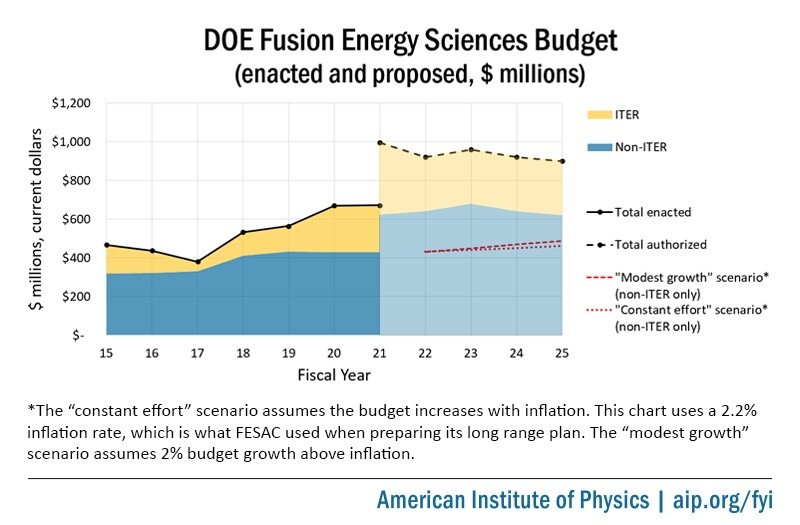
Final FY21 Appropriations: DOE Office of Science
With last month’s enactment of fiscal year 2021 appropriations legislation, the Department of Energy Office of Science’s budget of exactly $7 billion is rising by $26 million, with each of its six programs funded at or just above their fiscal year 2020 levels. The appropriation does not include any “emergency” stimulus spending on research facilities, as House Democrats had proposed
An explanatory statement

Crosscutting initiatives
QIS and AI. Congress directs the Office of Science to increase funding for artificial intelligence from $71 million to at least $100 million and for quantum information science from $195 million to at least $245 million. Of the QIS funding, $125 million is for the five research centers DOE established
Negative emissions technologies. The Office of Science is instructed to continue collaborating with DOE’s Office of Fossil Energy and Office of Energy Efficiency and Renewable Energy on developing methods of removing carbon dioxide from the atmosphere. The amount specified by Congress for the Office of Science’s contribution is increasing from at least $20 million to at least $22.5 million, which includes at least $7.5 million for direct air capture technology. This funding is drawn from the office’s Basic Energy Sciences and Biological and Environmental Research programs.
Collaboration with NIH. Congress continues to encourage DOE to expand collaboration with the National Institutes of Health, and provides $1 million for projects that leverage DOE’s data and computational capabilities.
High Energy Physics
Following several years of significant growth, the HEP budget is remaining essentially flat at $1.05 billion. Increasing construction costs within that budget could put further pressure on funding for research and technology R&D, which a recent independent review
LBNF/DUNE and PIP-II. The budget for the flagship Long-Baseline Neutrino Facility and Deep Underground Neutrino Experiment project is staying even at $171 million, while the budget for the associated Proton Improvement Plan II accelerator upgrade at Fermilab is increasing from $60 million to $79 million. Congress also directs DOE to allocate at least $30 million for the Sanford Underground Research Facility in South Dakota, where the DUNE detectors will be installed. Appropriators did not comment on the 40% increase in total project cost for LBNF/DUNE that DOE reported in its budget request, and which stemmed from
LHC upgrades. Congress notes in the explanatory statement that it does not provide any specific funding or policy direction regarding DOE’s contribution to the high-luminosity upgrade to the Large Hadron Collider at CERN and associated upgrades to the CMS and ATLAS detectors. All three projects have been delayed
Mu2e and SuperCDMS. DOE reported
Rubin Observatory. DOE also reported that LSSTCam, a central component of the Vera C. Rubin Observatory, requires an additional $5.5 million in operating funds to complete assembly due to pandemic-related disruptions. Congress directs DOE to allocate at least $18.5 million to operation of the observatory and notes that, as with SuperCDMS, it supports activities toward completion of the telescope.
CMB-S4. Congress directs DOE to allocate at least $6 million in initial funding for the Cosmic Microwave Background-Stage 4 experiment, exceeding the requested $1 million. The project is among the few remaining projects
Fusion Energy Sciences
Although the new Energy Act

Click to enlarge
ITER. DOE’s contribution to ITER will remain level at $242 million, of which $60 million is for cash contributions. Congress also directs DOE to submit baseline cost and schedule estimates for the project, which have previously been left open-ended.
Private fusion ventures. Congress specifies level funding of $4 million for the Innovation Network for Fusion Energy (INFUSE) program, which supports collaborations between DOE labs and private fusion energy ventures. The Energy Act also creates a new program for fusion ventures that will reimburse costs once defined milestones are achieved. That program is not funded in this year’s appropriation, but the act recommends Congress allocate $325 million for it distributed over five years.
MEC Upgrade and MPEX. The petawatt power upgrade to the Matter in Extreme Conditions end station at SLAC’s Linac Coherent Light Source and the Materials Plasma Exposure eXperiment at Oak Ridge National Lab will receive level funding of $15 million and at least $21 million, respectively.
Basic Energy Sciences
The BES budget is increasing by 1% to $2.25 billion. All BES research centers and user facilities will receive steady funding, as will the program’s suite of light and neutron source upgrades, the construction of new National Synchrotron Light Source II beamlines, and equipment recapitalization at the five Nanoscale Science Research Centers. The Linac Coherent Light Source II facility at SLAC National Accelerator Lab is receiving $33 million it needs to continue toward completion
Nuclear Physics

Senate Minority Leader Chuck Schumer (D-NY), Rep. Lee Zeldin (R-NY), DOE Under Secretary for Science Paul Dabbar, and Brookhaven National Lab Director Doon Gibbs were among those who participated in a ribbon-cutting ceremony to mark the launch of the lab’s Electron-Ion Collider project last fall.
(Image credit – Brookhaven National Lab)
The NP budget is holding steady at $713 million. Funding for early work on the flagship Electron-Ion Collider facility at Brookhaven National Lab is doubling from $11 million to at least $22 million. The project is expected to cost between $1.6 billion and $2.6 billion altogether. Other, smaller-scale projects will receive funding at or above the amounts requested for them.
Isotope program. The House’s proposal to provide $10 million to establish a university research consortium focused on advanced manufacturing techniques for radioisotope production is rejected, and DOE is instead directed to submit a plan for such a program. Separately, Congress provides $1 million to establish a “traineeship program for students to develop the future workforce of radioisotope production.” Via the House report, Congress “acknowledges” DOE’s separation
Advanced Scientific Computing Research
ASCR is receiving a 4% increase that brings its budget above the $1 billion mark for the first time, nearly double its fiscal year 2015 level. As DOE’s ongoing exascale computing project nears its conclusion, much of its construction budget is shifting to research, with funding increasing from $195 million to at least $250 million The budgets for DOE’s leadership computing facilities and the National Energy Research Scientific Computing Center will stay at least level.
Exascale computing. Overall funding across the Office of Science for DOE’s Exascale Computing Initiative is increasing from $464 million to at least $475 million. The first exascale computer in the U.S. is expected to be installed at Oak Ridge National Lab this year, but another machine at Argonne National Lab, which was scheduled to be completed first, has been delayed
Biological and Environmental Research
The BER budget is increasing $3 million to $753 million. Within that, funding for Biological Systems Science is decreasing from $405 million to no less than $390 million, while Earth and Environmental Systems Sciences funding is increasing from $345 million to at least $350 million. The four Bioenergy Research Centers will receive at least level funding of $100 million overall and the Joint Genome Institute budget will increase at least $3 million to $80 million. Congress continues to direct that the recently reconstituted low-dose radiation research program receive at least $5 million and instructs DOE to work with other agencies to develop a “proper role and direction” for it. The Energy Act recommends that Congress ramp up the program’s budget to $40 million by fiscal year 2024.


